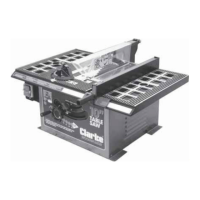19
Notches are provided in the mitre gauge head for
attaching an AUXILIARY FACING to make it easier to
cut longer pieces. Ensure the facing does not extend
so far as to interfere with the proper operation of the
Saw Blade Guard.
Select a suitable piece of smooth straight wood, drill
two holes through it and attach it with screws.
HINT: Glue a piece of sandpaper to the face of the
mitre gauge head or auxiliary facing. This will help
prevent the workpiece from creeping whilst being cut.
When crosscutting, you should ALWAYS abide by the following rules:
1. Never make these cuts freehand (without using the mitre gauge or other auxiliary device)
because the blade could bind in the cut and cause a kickback or cause your fingers or
hand to slip into the blade.
2. Always lock the mitre gauge securely when in use.
3. Remove rip fence from table during any operations which utilise the mitre gauge.
4. Make sure blade guard is installed (for all sawing operations).
5. Set the saw blade height to the thickness of the wood plus 2-3mm. Additional blade
exposure would increase the hazard potential.
6. Do not stand directly in front of the blade in case of a throwback (small cutoff piece
caught by the back of the blade and thrown toward the operator). Always stand to
one side of the blade.
7. Keep your hands clear, and out of the path of, the blade.
8. If blade stalls or stops while cutting, switch the machine OFF and disconnect from the
mains supply, before attempting to free the blade.
9. Do not reach over or behind the blade to pull the workpiece through the cut, to support
long or heavy workpieces, to remove cutoff pieces of material, or for any other reason.
10. Do not pick up small pieces of cutoff material from the table. Remove them by pushing
them off the table with a long stick. Otherwise they could be thrown back at you by the
rear of the blade.
11. Do not remove small pieces of cutoff material that may become trapped inside the
blade guard while the saw is running. This could endanger your hands or cause a
kickback. Turn the saw off. After the blade has stopped turning, lift the guard and remove
the trapped piece.
12. If workpiece is warped, place the concave side down. This will prevent it from rocking
while it is being cut.
5. Repetitive Cutting
Repetitive cutting is the term used when cutting a quantity of pieces of the same length
without having to mark each piece.
When making repetitive cuts from a long workpiece, make sure it is supported.
1. When making repetitive cuts, clamp a block of wood 75mm (3”) long to the table at
the desired length to act as a length stop.
NOTE: When clamping the block, make sure that the end of the block is well in front of the saw blade. Be
sure it is clamped securely.

